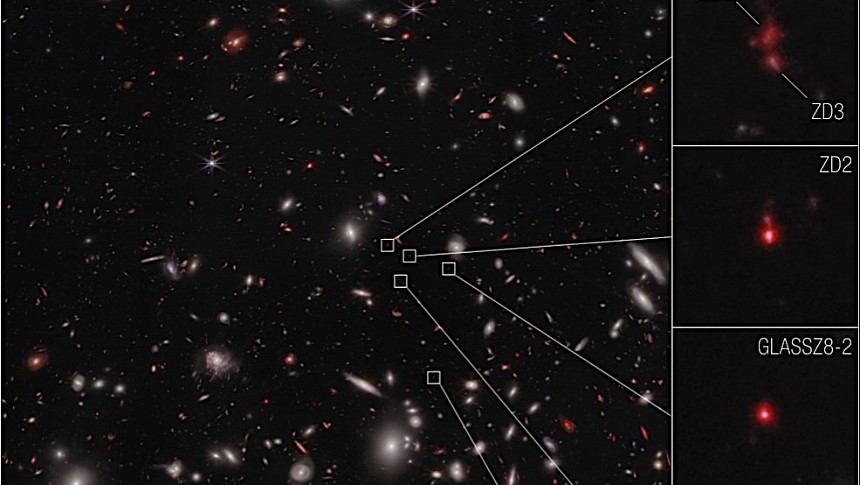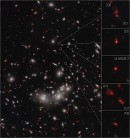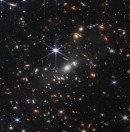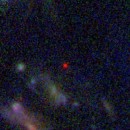When NASA finally launched the James Webb Space Telescope (JWST) at the end of 2021, it made no secret as to the scope of its mission: to unravel some of the Universe's biggest mysteries for us. Aided by some of the most advanced tech humanity can produce, Webb has already begun to do that.
For the better part of its first year in space Webb has been directed at various points of interest for calibration and other such purposes. It spied on the planets in our own solar system and places so far from us that just imagining the distances involved would make our heads spin.
Every single discovery the telescope made is relevant in one way or another, but the one we're here to talk about now has to do with Webb's true purpose.
Earlier this week, NASA published some details on Webb's findings after it looked at something the agency calls "an early-universe prequel to huge galaxy cluster." In words we can all understand, the telescope was capable of seeing light coming from 650 million years after the Big Bang. And not only did it see it, but also helped scientists better determine what's there.
The main photo of this piece shows five tiny squares, enlarged to the side of the pic for us to better understand what we're looking at. Those tiny specs of reddish light are in fact early galaxies, racing through space at speeds of two million miles per hour (3.22 million km per hour) and coming together to form a galaxy cluster. That would be a close gathering of an uncountable number of galaxies, so packed together that they form the "greatest concentrations of mass in the known universe."
We know of several such things, the most important and among the largest being the Coma Cluster, repeatedly under the watchful eye of another telescope of great fame, Hubble. Coma is incredibly large, spanning 20 million light-years in diameter and comprising thousands of individual galaxies.
By comparison, Webb's proto-cluster so far has only seven galaxies we know of. Or, had, because these things are so far out that we're actually looking at light-generated eons in the past.
Since it's impossible to know how the cluster looks now (light generated by it today will reach us so far into the future it won't even matter to us), scientists have used spectral data to model the cluster's evolution. And they found it will likely grow (has grown) to become about as large as Coma.
Webb's finding is important because this is the first time we were able to see a protocluster from so far out in space and time. For reference, 650 million years after the Big Bang is still 13 billion years in our past, and the perfect time to study the early years of not only galaxy clusters, but galaxies themselves.
The finding also proved just how capable Webb is, and it now has scientists dreaming of using the telescope's instruments to map dark matter. Exciting times ahead, so stay tuned…
Every single discovery the telescope made is relevant in one way or another, but the one we're here to talk about now has to do with Webb's true purpose.
Earlier this week, NASA published some details on Webb's findings after it looked at something the agency calls "an early-universe prequel to huge galaxy cluster." In words we can all understand, the telescope was capable of seeing light coming from 650 million years after the Big Bang. And not only did it see it, but also helped scientists better determine what's there.
The main photo of this piece shows five tiny squares, enlarged to the side of the pic for us to better understand what we're looking at. Those tiny specs of reddish light are in fact early galaxies, racing through space at speeds of two million miles per hour (3.22 million km per hour) and coming together to form a galaxy cluster. That would be a close gathering of an uncountable number of galaxies, so packed together that they form the "greatest concentrations of mass in the known universe."
We know of several such things, the most important and among the largest being the Coma Cluster, repeatedly under the watchful eye of another telescope of great fame, Hubble. Coma is incredibly large, spanning 20 million light-years in diameter and comprising thousands of individual galaxies.
By comparison, Webb's proto-cluster so far has only seven galaxies we know of. Or, had, because these things are so far out that we're actually looking at light-generated eons in the past.
Since it's impossible to know how the cluster looks now (light generated by it today will reach us so far into the future it won't even matter to us), scientists have used spectral data to model the cluster's evolution. And they found it will likely grow (has grown) to become about as large as Coma.
Webb's finding is important because this is the first time we were able to see a protocluster from so far out in space and time. For reference, 650 million years after the Big Bang is still 13 billion years in our past, and the perfect time to study the early years of not only galaxy clusters, but galaxies themselves.
The finding also proved just how capable Webb is, and it now has scientists dreaming of using the telescope's instruments to map dark matter. Exciting times ahead, so stay tuned…






